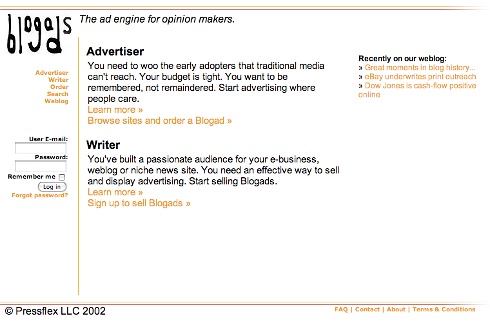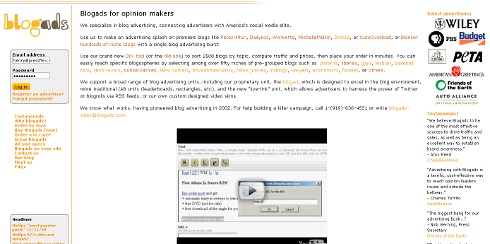19 ideas for start-ups
by henrycopelandTuesday, March 9th, 2010
Got a brilliant product idea? Thinking about starting a company? Here are a few of the lessons I’ve learned as an entrepreneur over the last 12 years:
- Your plans are already history…

http://www.flickr.com/photos/nnova/3976614059/
Don’t worry about your product. Five years from now, there’s only a 1 in 20 chance you’ll be selling that wonderful product you’re sketching today on napkins.
- Hire for tomorrow’s products…

http://www.flickr.com/photos/oaspetele_de_piatra/2680418274/
iPad and Google and Twitter are an effect of great companies, not the cause. Focus on people before products.
- Dream…

http://www.flickr.com/photos/getdown/452253741/
At the heart of every start-up is a dream, a hallucination, a vision nobody else sees. Bandages for invisible wounds. Shampoo for bald men. A hot air balloon, not a pile of cloth. Every start-up needs a dreamer, someone who is, by conventional standards, a little crazy.
- Partner well…

http://www.flickr.com/photos/nunoduarte/
It takes (at least) two to tango. The dreamer needs partners — spouses, colleagues, investors, family, customers — sane, practical people willing to make a leap of faith and dance even when sometimes they don’t hear the music.
- Ignore the champagne…

http://www.flickr.com/photos/jarbo/
Start-ups require patience and humility. Don’t break out the champagne when you sign your first contract, or get featured in the Wall Street Journal. These events are bubbles, quick to burst, meaningless side-effects of your real, if tiny, daily achievements.
- Stay late…

http://www.flickr.com/photos/mayeve/
A start-up’s water boils only because of thousands of small actions: sending an e-mail at 7.45 AM before your competitors have gotten into the office, grabbing the thesaurus one more time to find the perfect verb, staying at your conference booth until everyone has left the hall.
- Network…

Avoid being either too insular or too networked. Maintain a healthy mix of links to people near and far, but not so many that you’re overwhelmed. A study of Broadway producers found that shows by producers with a mixed social network did better than shows by producers who always work together or producers who’ve never worked together.
- Reboot…

http://www.flickr.com/photos/mayeve/
Amid the dreaming and screaming and scheming, take a vacation. Go away for a full week with no phone or computer. At least once every three to six months, you HAVE to unplug completely for at least a week to reboot your brain and reconnect with your family.
- Hire happy people…

http://www.flickr.com/photos/stollerdos/
This rule seems obvious, but is easy to overlook amid piles of resumes and criteria. Happy teachers are 43% more effective than average teachers, and the same rule applies to small companies.
- Meet the mate…

http://www.flickr.com/photos/8533266@N04/
If you’re hiring someone with a significant other, you’ve got to meet that person. He or she shows a lot about your potential hire. Plus you’re all going on a long ride together and its a lot more fun if you all get along.
- Don’t ignore warts…

http://www.flickr.com/photos/cdhc/
When hiring, avoid wishful thinking. We all like to think the best of people, particularly when that person might make a great contribution to your cause. But once you’ve hired someone, their bad habits can quickly becomes horror shows.
- Interview by e-mail…

http://www.flickr.com/photos/edyson/1827140411/
Most extra-corporate interactions are now virtual — 94% e-mail, 4% IM, 2% phone? — so try to get to know job candidates the way your customers will. Before meeting in person, interview by e-mail, IM, then phone.
- Climb two ways…

http://www.flickr.com/photos/kpalyu
Some people are great at building ladders, some people excel at climbing them. Early in a start-up’s life, you need people who can build a ladder out of thin air. Then you hire great climbers.
- Hire people who tolerate failure…

http://www.flickr.com/photos/acaben/
A good baseball player misses roughly 90% of all pitches. Your staff need to keep swinging and missing as eagerly as any Major League slugger.
- Hire people who enjoy each other…

This is a photo I took of a Blogads cookout. A company is more than a crowd of people — put the right people together and some special fire kindles among them and great things happen. Get it wrong, and your company is cold and dark.
- Hold on to great staff…

http://www.flickr.com/photos/joyoflife/
Over time, your colleagues amass volumes of knowledge about your products, markets and customers. Increase retention of great staff by just 10% and you can double profits.
- Beware your first sale…

http://www.flickr.com/photos/santos/
No matter how absurd the product, there’s always at least one buyer out there. Maybe your mom, maybe your college roommate. Never extrapolate from your first sale… or you may end up with a pile of purple eggs.
- Court networked customers…

http://www.flickr.com/photos/svedek/
It’s much better to sign three customers who know each other than ten who have no connection. Connected customers imitate, educate and evangelize each other. They’re the nucleus of growth.
- Embrace smart customers and don’t let go…

http://www.flickr.com/photos/formalfallacy/
Smart customers demand smart products. And long-time customers value your service more. If you’ve tailored your products to their needs, you’ve helped make them happier or more profitable. Improving customer retention by 10% can boost profits by 30%.
The bottom line: a start-up needs to focus more on people than products. Only persistent, loyal, smart staff and customers can make a dream soar into the clouds.
(These are all lessons I’ve learned over 30 years of working for small, privately held companies, including 12 years running my own company with great partners. Some are tactics I’ve only recently articulated, some are ideals I’ve failed to live up to. Throughout, I’ve relied on invaluable books like The Innovator’s Dilemma, Crossing the Chasm, The Psychology of Persuasion, Connected, Linked, and The Loyalty Effect.)
Other blog posts of interest: Reid Hoffman’s 10 rules for entrepreneurs.



